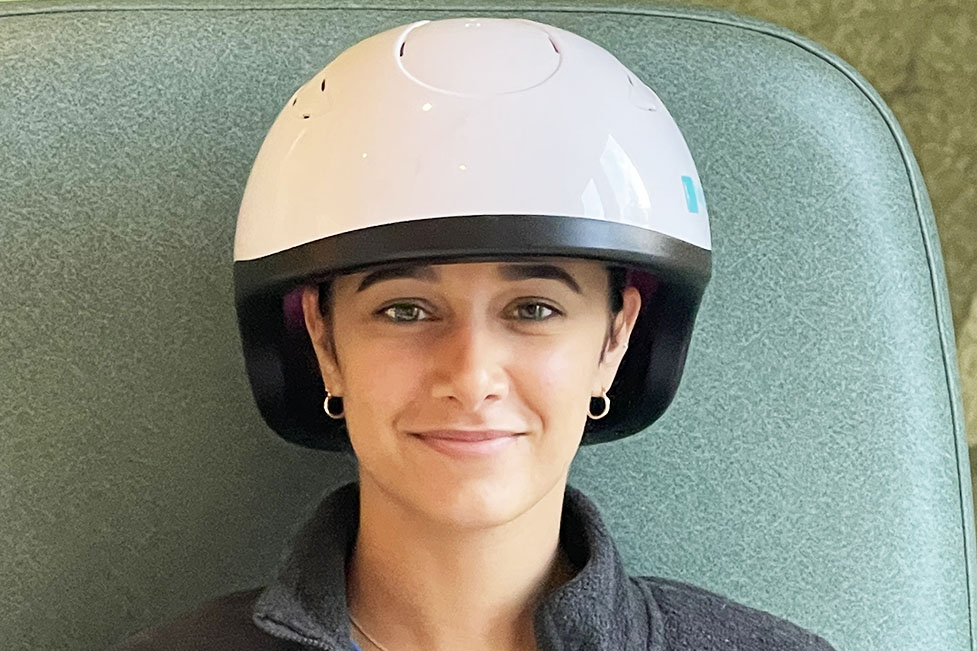Introduction to the Weber LED Infrared Helmet
The Weber LED Helmet uses transcranial photobiomodulation therapy to address a number of concerns related to brain function and health.
The sophisticated device uses specific infrared light that is able to penetrate the skull and provide therapy to targeted brain areas. Using the Weber LED Helmet is non-invasive and painless. There is also no heat generated during use making it nonthermal.
The transcranial photobiomodulation technology used with the Weber LED Helmet has been used for Alzheimer’s Disease symptoms as well as improvement of symptoms related to Parkinson’s Disease, depression, and traumatic brain injuries (TBI).
The Weber LED Helmet can be personalized with multiple different settings available for use. There are various intensity levels, frequencies, and treatment times depending on a person’s needs.
Benefits of the Infrared Helmet
Benefits of the Weber LED Helmet including stimulating energy production in the brain and improving oxygen availability.
Cerebral blood flow and lymphatic flow can also be improved.
There can even be improvements in the protective features of the brain including anti-oxidant effects and improving the life cycle of cells.
These benefits can all translate into improvements in many common symptoms related to brain diseases. Here are a few brain disorders that have been improved by transcranial photobiomodulation technology:
- Alzheimer’s Disease
- Parkinson’s Disease
- Victims of Stroke
- Depression
- Traumatic Brain Injury
Benefits may include increased focus, cognitive function, less brain fog, and improved speech. Difficulties with walking or fine motor skills due to brain injury can be improved with transcranial photobiomodulation as well.
How the LED Helmet Works
The Weber LED Infrared Helmet looks very similar to a bicycle helmet, complete with foam pads to adjust for comfort and size. There are 320 diodes that are controlled through a handheld device that is connected via a chord to the helmet where treatment settings can be set. This includes setting duration (1-30 minutes), four intensity levels, and frequency (1 Hz – 20,000 Hz).
It is recommended to wear the Weber LED Helmet for 15-30 minutes daily or weekly, but a treatment plan is made with your practitioner to determine the best settings and duration for therapy.
Transcranial LED photobiomodulation has been shown to penetrate 4-5cm past the skull into brain tissue for direct therapeutic benefits.
Signaling pathways including molecular and intracellular pathways are activated by the LED diodes which can lead to tissue and circulation improvements.
See how we can help you restore complete health of body, mind & spirit.
Join our mailing list and receive exclusive offers + information!
Behind the Science
Science & Safety
Shining light on the head: Photobiomodulation for brain disorders, BBA Clinical (2016) BBA Clinical (2016)
Molecular and intracellular mechanisms of transcranial low-level laser (light) or photobiomodulation.
Cytochrome c oxidase and heat-gated ion channels are two of the most important molecular photoreceptors or chromophores inside neuronal cells. They absorb photons that penetrate into the brain.
The signaling pathways and activation of transcription factors lead to the eventual effects of PBM in the brain.
1. Short-term stimulation: ATP, blood flow, lymphatic flow, cerebral oxygenation, less edema
2.Neuroprotection: Upregulation of anti-apoptotic proteins, less excitotoxity, more antioxidants, less inflammation
3.Processes that help the brain to repair itself: Neurotrophins, neurogenesisand synaptogenesis
The Efficacy of 904 nm Laser Therapy for Alzheimer’s Diseases Radiology and Nuclear Medicine (VUmc)
Infrared light has been found to stop neuronal death which is a common cause of symptoms related to Alzheimer’s Disease. Laser therapy was shown to decrease the progression of Alzheimer’s Disease and improve behavior including improving the ability to have a conversation, reduce nervousness, and increase sociability.
Management of Post-Traumatic Stress (PTSD) Dementia and Other Neuro-Degenerative Disease with Photo-Medicine Open Journal of Psychiatry > Vol.7 No.4, 2017
The potential of transcranial photobiomodulation therapy for treatment of major depressive disorder Rev Neurosci . 2017
The exposure of PFC region using transcranial PBM therapy has potential antidepressant-like effects in MDD patients as it increases cerebral energy production via mitochondrial oxidative phosphorylation and enhances frontal cortex oxygen consumption.
In addition, TLLLT led to a significant increase in the left middle cerebral artery (up to 30%) and basilar artery (up to 25%) blood flow velocity.
TLLLT may result in significant amelioration of the symptoms and may serve as a potential treatment regimen for MDD patients.
Weber LED Infrared Helmets are considered safe, painless, noninvasive, and non-thermal.
Spectrum
Where does the Weber LED Infrared Helmet fall on the medical spectrum?
The helmet falls under the ‘Energy Medicine’ section of the medical spectrum.
Receiving Therapy
Receiving Weber LED IR Helmet Treatment
We are pleased to offer Weber LED Infrared Helmet treatments at our clinic, the New York Center for Innovative Medicine (NYCIM). However, the use of this or any of our numerous therapeutic options is only performed on patients after an in-depth health evaluation. We also offer the ability to purchase the LED helmet to patients of our clinic.
PODCAST - The Story of Weber Lasers

-
See if the Weber IR Helmet is right for you.
- Our clinic has helped thousands from around the world. Find out if we can help you.
- Take the Quiz
More Info
Resources & Experts
- The Story of IV Laser Therapy with Dr. Michael Weber and Jennifer Miele
Your Health. Your Story. Podcast
- Dr. Mark Iwanicki Explains the Weber LED Infrared Helmet – Video 1
Video
- Dr. Mark Iwanicki Explains the Weber LED Infrared Helmet – Video 2
Video
- Weber Medical – Weber LED Infrared Helmet Introductory PDF
PDF
- Weber LED Infrared Helmet Frequency Recommendations
PDF
- The Weber Laser Watch: A Product Review
Article
- Dr. Weber Explains How Red, Green, and Blue Lasers Impact the Body
Article and Video
Frequently Asked Questions
What is the Weber LED Infrared Helmet?
The Weber LED Infrared Helmet is a device that provides transcranial LED and low-level light therapy via a highly personalized and noninvasive method where a helmet is worn on the head. The helmet contains 320 diodes set at 810nm. Optimum wavelength for maximum skull penetration is between 805 nm and 830 nm (infrared). Studies show that the light reaches a depth of 4-5 cm past skull (or 3 cm into brain).
Transcranial Low-Level Laser Therapy (TLLLT) is the direct irradiation of the human brain with highly focused infrared lasers. Unlike other wavelengths, infrared light has the ability to penetrate bones and to bring light energy to the targeted brain areas. Light energy is absorbed by different types of cells to trigger a broad range of intra-cellular effects.
What is the Weber LED Infrared Helmet used for?
The Weber LED Infrared Helmet is used to activate various pathways in the brain to improve symptoms related to a number of brain disorders including dementia, Parkinson’s, depression, and stroke.
How long does a Weber LED Infrared Helmet treatment take?
Treatment can last from 1-30 minutes and is recommended to do 1-2 times per day/week depending on practitioner recommendations.
Schedule Now
Weber LED Infrared Helmet
Curious if this therapy is right for you? Take our quiz to see if you’re a candidate and book a free consultation with an Innovative Medicine Patient Ambassador.
or Contact Us


















